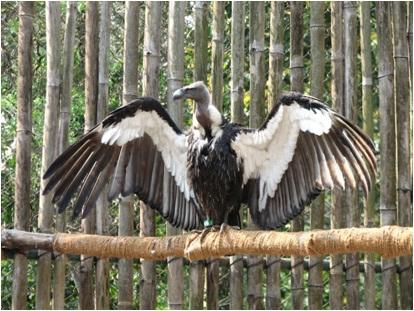It is well known that the three Gyps species of vultures in India had drastically declined by about 99% over the past two decades. BNHS-India, in association with UK-based Royal Society for the Protection of Birds (RSPB) and several state governments in India, has been trying to conserve them through captive breeding, research and advocacy. The recent Extraordinary Notification number 450 in the Gazette of India, published on 17th July 2015 by the Ministry of Health and Family Welfare, Government of India, is a big relief to these Critically Endangered vulture species.
The Notification and its impact
The recent Notification has declared that from now onwards the diclofenac formulation for human use will be available as single dose vials of three ml only. This will prevent its misuse on cattle. This inexpensive non steroidal anti-inflammatory drug is effective for treating pain and inflammation in cattle and humans, but is toxic for vultures, according to studies conducted by BNHS and other organizations. Vultures - nature’s most efficient scavengers - primarily scavenge on dead bodies of wild animals and domestic ungulates and have been dying on a mass scale after feeding on carcasses that were administered diclofenac 72 hours prior to their death. They suffer from renal failure and deposition of uric acid on visceral organs due to diclofenac.
The drug was banned by the Drug Controller General of India in 2006 for veterinary use after efforts from BNHS and other organizations. But further surveys by BNHS had revealed that multi-dose vials of the drug meant for humans were still being used on cattle. The multi-dose vials for humans were till now available in 30 ml whereas the advisable dose is three ml for humans and 10-15 ml for adult cattle, leading to misuse. Subsequently only three companies in India had voluntarily ceased production and over 70 others ignored the requests. BNHS and other organizations brought the misuse to the notice of the authorities 3-4 years ago and persistent advocacy eventually resulted in this Notification. This will go a long way in preventing the possible extinction of vultures by drastically reducing the misuse of multi-dose vials, without any significant threat for the legitimate use on humans.
Background of vulture crisis
Populations of the three species; viz. Oriental White-backed, Long-billed and Slender-billed Vulture; which were once common (over four crore), started declining in South Asia since the early 1990s to just about one lakh by 2007. In response to the population crash, scientists from BNHS and RSPB, along with state forest departments have been successfully running four vulture breeding centres in Haryana, West Bengal, Assam and Madhya Pradesh; along with lab-based research, advocacy and field research such as carcass sampling for nearly a decade now. The SAVE (Saving Asia’s Vultures from Extinction) consortium bringing together national and international experts was launched in 2011 to help coordinate research, advocacy at policy and public levels and implementation of the actions needed to prevent extinction. Further, as a part of advocacy efforts, proactive attempts are being made to keep at least 100 sq km area of natural habitats, called as Vulture Safe Zones, across the subcontinent, free from diclofenac.
Download: Gazette notification on ban on multidose vials of diclofenac







Add new comment